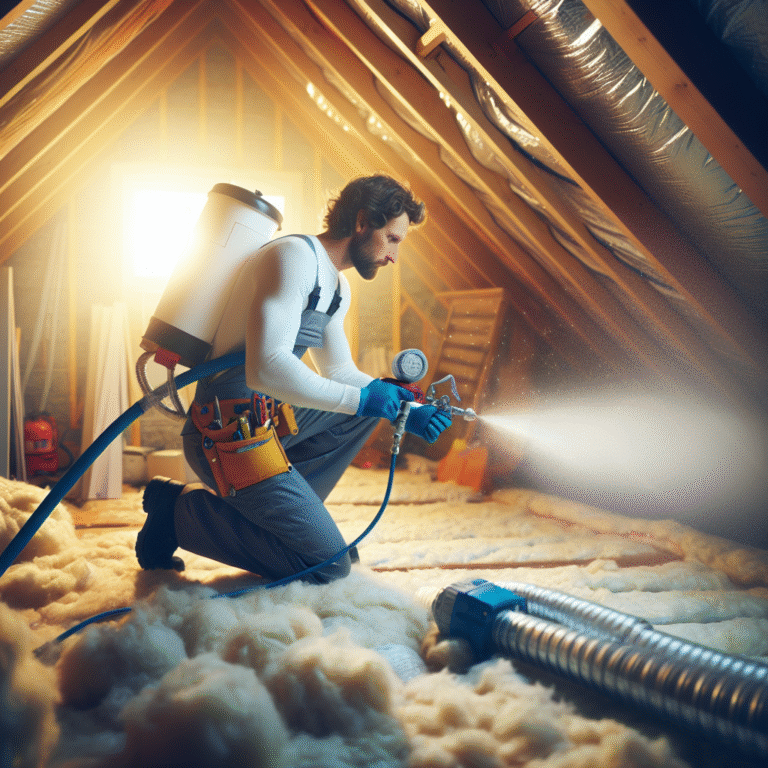-
Table of Contents
- Introduction
- Benefits of Weatherproofing Your Home with Blown-In Insulation in Houston
- How Professional Consulting Can Help You Achieve an Energy Efficient Home with Blown-In Insulation
- The Process of Weatherproofing Your Home with Blown-In Insulation: What to Expect from a Professional Service
- Q&A
- Conclusion
Protect your home from the elements with blown-in insulation in Houston.
Protect your home from extreme weather conditions in Houston with blown-in insulation. Upgrade your insulation today and save on energy costs. Visit texasinsulationsolution.com to learn more and schedule a consultation.”
Introduction
Weatherproofing your home is an essential step in ensuring that your home is comfortable and energy-efficient. One effective way to weatherproof your home is by using blown-in insulation. This type of insulation is particularly beneficial for homes in Houston, where the weather can be hot and humid. In this article, we will discuss the benefits of blown-in insulation and how it can help weatherproof your home in Houston. By the end, you will have a better understanding of why blown-in insulation is a smart choice for homeowners in Houston looking to weatherproof their homes.
Benefits of Weatherproofing Your Home with Blown-In Insulation in Houston
Weatherproofing your home is an essential step in maintaining a comfortable and energy-efficient living space. In a city like Houston, where the weather can be unpredictable and extreme, it is crucial to take measures to protect your home from the elements. One of the most effective ways to weatherproof your home is by using blown-in insulation. This type of insulation offers numerous benefits, making it a popular choice among homeowners in Houston.
First and foremost, blown-in insulation is highly effective in keeping your home warm during the winter and cool during the summer. This is because it creates a barrier between the inside of your home and the outside environment. The insulation material, usually made of fiberglass or cellulose, traps air pockets, which act as a buffer against temperature changes. This means that during the winter, the warm air inside your home will not escape, and during the summer, the hot air outside will not seep in. As a result, your home will maintain a comfortable temperature, and you will not have to rely heavily on your heating or cooling systems, leading to significant energy savings.
Another benefit of blown-in insulation is its ability to reduce noise levels inside your home. The insulation material absorbs sound waves, making it an effective sound barrier. This is especially beneficial for homes located in busy areas or near highways, where external noise can be a nuisance. With blown-in insulation, you can enjoy a quieter and more peaceful living space.
In addition to temperature and noise control, blown-in insulation also helps to improve the air quality inside your home. The insulation material is treated with fire-retardant chemicals, which prevent the growth of mold and mildew. This is particularly important in a humid city like Houston, where moisture can easily seep into your home. By preventing the growth of mold and mildew, blown-in insulation helps to maintain a healthy living environment for you and your family.
Moreover, blown-in insulation is a cost-effective option for weatherproofing your home. Unlike traditional insulation methods, such as batt insulation, which requires cutting and fitting pieces of insulation, blown-in insulation is installed using a special machine. This makes the installation process quicker and more efficient, resulting in lower labor costs. Additionally, the insulation material is usually made from recycled materials, making it an environmentally friendly choice. With blown-in insulation, you can save money on installation costs and contribute to a greener planet.
Furthermore, blown-in insulation is a long-lasting solution for weatherproofing your home. The insulation material is designed to be durable and resistant to pests, such as rodents and insects. This means that once installed, you will not have to worry about replacing or repairing your insulation for many years to come. This makes it a cost-effective investment in the long run.
Lastly, blown-in insulation can also increase the value of your home. With energy efficiency becoming a top priority for homebuyers, having blown-in insulation can make your home more attractive to potential buyers. It also shows that you have taken the necessary steps to protect your home from the elements, making it a more desirable and valuable property.
In conclusion, blown-in insulation offers numerous benefits for weatherproofing your home in Houston. From energy savings to noise reduction and improved air quality, this type of insulation is a cost-effective and long-lasting solution. So if you want to make your home more comfortable, efficient, and valuable, consider weatherproofing it with blown-in insulation.
How Professional Consulting Can Help You Achieve an Energy Efficient Home with Blown-In Insulation
As a homeowner in Houston, you are no stranger to the extreme weather conditions that can occur throughout the year. From scorching hot summers to unpredictable hurricanes, your home must withstand a variety of elements. One way to ensure that your home is well-equipped to handle these weather changes is by weatherproofing it with blown-in insulation.
Blown-in insulation, also known as loose-fill insulation, is a type of insulation that is installed by blowing it into the walls, attic, or other spaces in your home. This method of insulation is becoming increasingly popular among homeowners in Houston due to its many benefits, including energy efficiency and cost-effectiveness. However, achieving these benefits requires professional consulting to ensure that the insulation is installed correctly and effectively.
One of the main advantages of blown-in insulation is its ability to create an energy-efficient home. In Houston, where the summers can be brutal, having proper insulation is crucial in keeping your home cool and comfortable. Blown-in insulation is made up of small particles of materials such as fiberglass, cellulose, or mineral wool, which are blown into the walls or attic of your home. These particles create a dense layer of insulation that helps to trap heat in the winter and keep it out in the summer. This results in a more consistent and comfortable temperature inside your home, reducing the need for excessive air conditioning or heating.
However, achieving this level of energy efficiency with blown-in insulation requires professional consulting. A professional consultant will assess your home’s current insulation and determine the best type and amount of blown-in insulation needed for optimal energy efficiency. They will also ensure that the insulation is installed correctly, without any gaps or spaces that could compromise its effectiveness. This attention to detail is crucial in achieving the desired energy efficiency and saving on energy costs in the long run.
Another benefit of blown-in insulation is its cost-effectiveness. While the initial cost of installation may be higher than other types of insulation, such as batt or roll insulation, blown-in insulation can save you money in the long run. Its dense layer of insulation helps to reduce air leakage, which can account for up to 40% of a home’s energy loss. This means that your HVAC system will not have to work as hard to maintain a comfortable temperature, resulting in lower energy bills. Additionally, blown-in insulation has a longer lifespan than other types of insulation, meaning you will not have to replace it as frequently, saving you money in the long run.
However, to achieve these cost-saving benefits, it is essential to consult with a professional. A professional consultant will ensure that the insulation is installed correctly and evenly, without any gaps or spaces that could compromise its effectiveness. They will also use high-quality materials and techniques to ensure that the insulation lasts for many years, providing you with long-term cost savings.
In addition to energy efficiency and cost-effectiveness, blown-in insulation also offers other advantages, such as noise reduction and fire resistance. The dense layer of insulation helps to absorb sound, making your home quieter and more peaceful. It also has a higher fire resistance rating than other types of insulation, providing an added layer of safety for your home and family.
In conclusion, blown-in insulation is an excellent option for weatherproofing your home in Houston. Its energy efficiency, cost-effectiveness, and other benefits make it a popular choice among homeowners. However, to achieve these benefits, it is crucial to consult with a professional. They will ensure that the insulation is installed correctly and effectively, providing you with a comfortable, energy-efficient, and cost-effective home. So, if you want to weatherproof your home and enjoy all the benefits of blown-in insulation, be sure to consult with a professional today.
The Process of Weatherproofing Your Home with Blown-In Insulation: What to Expect from a Professional Service
Weatherproofing your home is an essential step in maintaining a comfortable and energy-efficient living space. In a city like Houston, where extreme weather conditions are a common occurrence, it is crucial to take the necessary measures to protect your home from the elements. One of the most effective ways to weatherproof your home is by using blown-in insulation. This method involves using a machine to blow loose insulation material into your walls, attic, and other hard-to-reach areas. In this article, we will discuss the process of weatherproofing your home with blown-in insulation and what you can expect from a professional service.
The first step in weatherproofing your home with blown-in insulation is to hire a professional service. While some homeowners may attempt to do it themselves, it is always best to leave this task to the experts. A professional service will have the necessary equipment, knowledge, and experience to ensure that the job is done correctly and efficiently. They will also be able to provide you with valuable advice on the type of insulation material that is best suited for your home.
Once you have hired a professional service, the next step is to schedule an appointment for them to come and assess your home. During this assessment, they will inspect your home’s current insulation and identify any areas that need to be addressed. They will also take measurements to determine the amount of insulation material needed for your home. This step is crucial as it ensures that the right amount of insulation is used, and there is no wastage of material.
After the assessment, the actual process of weatherproofing your home with blown-in insulation begins. The first step is to prepare the area where the insulation will be blown in. This involves covering any furniture, flooring, and other items that may be affected by the blowing process. The professionals will also take precautions to protect themselves by wearing protective gear.
Once the area is prepared, the professionals will use a machine to blow the insulation material into your walls, attic, and other areas. This process is quick and efficient, and it ensures that the insulation reaches all the nooks and crannies of your home. The insulation material used is usually made of recycled materials such as cellulose or fiberglass, making it an eco-friendly option.
After the insulation has been blown in, the professionals will clean up any excess material and ensure that your home is left in the same condition as before. They will also conduct a final inspection to ensure that all areas have been adequately insulated. This step is crucial as it ensures that your home is fully weatherproofed and ready to withstand any extreme weather conditions.
In addition to providing insulation, blown-in insulation also offers other benefits. It can help reduce noise levels, improve indoor air quality, and increase the overall energy efficiency of your home. This means that you will not only be protecting your home from the elements but also saving money on your energy bills in the long run.
In conclusion, weatherproofing your home with blown-in insulation is a crucial step in maintaining a comfortable and energy-efficient living space. By hiring a professional service, you can expect a thorough assessment, efficient installation, and a fully weatherproofed home. So, if you live in Houston, don’t wait any longer, weatherproof your home with blown-in insulation today and enjoy the benefits for years to come.
Q&A
Q: What is blown-in insulation?
A: Blown-in insulation is a type of insulation that is installed by blowing loose fibers or particles into the walls, attic, or other areas of a home to create a thermal barrier and improve energy efficiency.
Q: How does blown-in insulation help weatherproof a home in Houston?
A: Blown-in insulation helps weatherproof a home in Houston by filling in gaps and crevices in the walls and attic, preventing air leaks and reducing heat transfer. This helps keep the home cooler in the hot and humid Houston climate, reducing the strain on air conditioning systems and lowering energy costs.
Q: Is blown-in insulation a good choice for homes in Houston?
A: Yes, blown-in insulation is a good choice for homes in Houston. It is a cost-effective and efficient way to improve energy efficiency and weatherproof a home in the hot and humid climate. It can also help reduce noise levels and improve indoor air quality.
Conclusion
In conclusion, blown-in insulation is a highly effective and efficient way to weatherproof your home in Houston. It provides a barrier against extreme temperatures, reduces energy costs, and improves overall comfort and air quality in the home. With its easy installation process and long-lasting benefits, blown-in insulation is a smart investment for homeowners in Houston looking to improve the energy efficiency and durability of their homes. By properly weatherproofing your home with blown-in insulation, you can enjoy a more comfortable living space and save money on energy bills in the long run.




